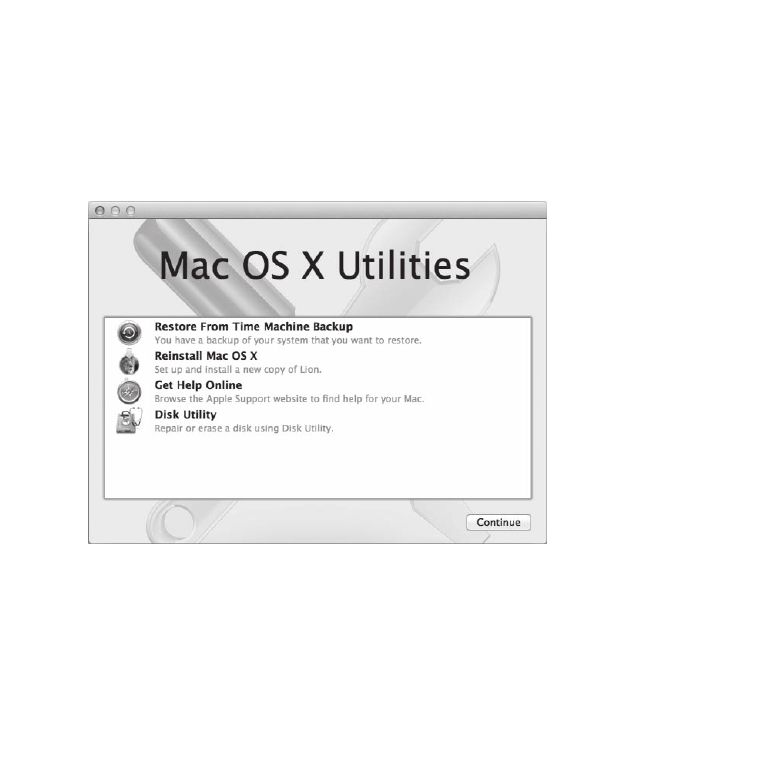
Problems That Prevent You from Using Your Mac mini
If your Mac mini won’t respond or the pointer won’t move
Â
Make sure the mouse and keyboard are connected. Unplug and then plug in the
connectors, making sure they’re secure. If you have wireless input devices, check that
the device batteries are charged. Try turning off and on any wireless device.
Â
Try to force problem applications to quit. On an Apple keyboard, hold down the
Option key and Command key (x) and then press the Esc key. On other keyboards,
hold down the Windows key and Alt key and then press the Esc key. If a dialog
appears, select the frozen application and click Force Quit. Then restart your Mac mini
to be sure the problem is entirely cleared up.
Â
Hold down the power button (®) on the back of your Mac mini for five seconds to
shut it down.
Â
Unplug the power cord from your Mac mini. Then plug the power cord back in and
press the power button (®) to turn your Mac mini on.

50
Chapter 4
Problem, Meet Solution
If the problem reoccurs when you use a particular application, check with the
application’s manufacturer to see if the application is compatible with the version of
Mac OS X installed on your Mac mini.
For support and contact information about the software that came with your Mac mini,
go to www.apple.com/downloads or to the manufacturer’s website.
If the problem occurs frequently, try repairing your disk, restoring your software from
a backup, or reinstalling your system software using the Mac OS X Utilities application
(see “Repairing, Restoring, or Reinstalling Mac OS X Software” on page 52).
If your Mac mini freezes during startup or you see a flashing question mark
Â
Wait a few seconds. If your Mac mini doesn’t start up, shut it down by holding down
the power button (®) for 8 to 10 seconds. Then hold down the Option key and
press the power button (®) again to start up your Mac mini. Keep holding down the
Option key until your Mac mini starts up, then click the arrow under the icon of the
hard disk you want to use as your startup disk.
After your Mac mini starts up, open System Preferences and click Startup Disk. Select
a local Mac OS X system folder.
Â
If the problem occurs frequently, you may need to reinstall your system software
(see “Repairing, Restoring, or Reinstalling Mac OS X Software” on page 52).
If your Mac mini doesn’t turn on or start up
Â
Make sure the power cord is plugged into your Mac mini and into a functioning
power outlet.

51
Chapter 4
Problem, Meet Solution
Â
Restart your computer while holding down the Command key (x) and R key, until
the computer restarts. When the Mac OS X Utilities application appears, select an
option to repair your disk, restore your software, or reinstall Mac OS X and Apple
applications from the Mac OS X Utilities pane. For more information, see “Repairing,
Restoring, or Reinstalling Mac OS X Software” on page 52.
Â
Press the power button (®) and immediately hold down the Command (x), Option,
P, and R keys on an Apple keyboard until you hear the startup sound a second time.
This resets the parameter RAM (PRAM). On other keyboards, press the power button
(®) and immediately hold down the Windows, Alt, P, and R keys.
Â
Unplug the power cord and wait at least 30 seconds. Plug the power cord back in
and press the power button (®) again to start up your Mac mini.
Â
If you still can’t start up your Mac mini, see “Learning More, Service, and Support” on
page 62 for information about contacting Apple for service.
If your Mac mini can’t connect to another computer’s optical disc drive
To use services such as Migration Assistant, DVD or CD Sharing, and iTunes music
sharing, both your Mac mini and the other computer must be connected to the same
network. If your Mac mini is connected wirelessly and the other computer is connected
to a third-party router by Ethernet, check your router documentation to make sure it
supports bridging a wireless to wired connection.
If your date and time settings get lost repeatedly
Â
You may need to have the internal backup battery replaced. For information about
contacting Apple for service, see “Learning More, Service, and Support” on page 62.

52
Chapter 4
Problem, Meet Solution